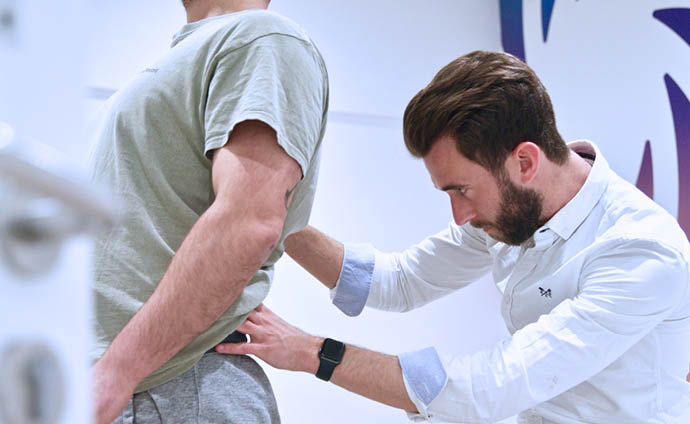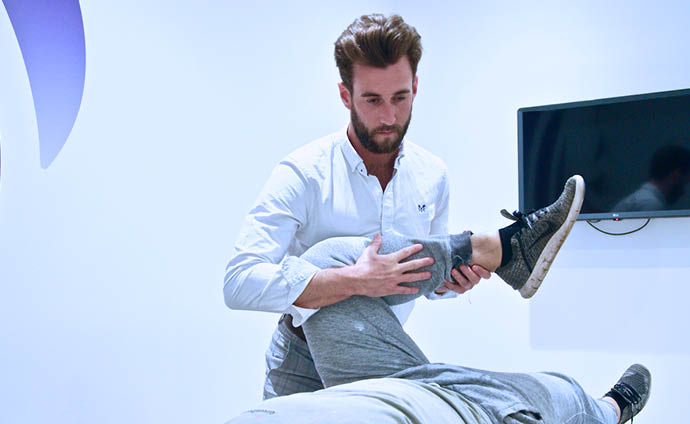Rob Foyster is one of the Directors and Lead Physiotherapists at Spectrum’s London clinic. He specialises in musculoskeletal conditions, spinal rehabilitation and is passionate about helping patients achieve their health-related goals and staying pain-free.
This is a real case study from one of his recent patients, a 35-year old male suffering from shoulder pain. The following words, written by Rob, will give you an insight into what it’s like being treated at Spectrum — from assessment right through to discharge.
I had a patient come in to see me, he was 35 years old, an investment banker who spent a lot of time sitting at a desk but also stayed fit and active as a member of an F45 Gym. When he presented to me he had been suffering for 10 days with increasingly bad shoulder pain. It had got to the point that it was a constant dull ache, plus sharp pain with certain movements, particularly anything over shoulder height or behind his body.
I ran a series of tests to rule different conditions in or out, such as O’Briens test, which involves straightening your arm and then rotating it so your palm faces downwards, with him pushing upwards and me pushing downwards on his hands to stabilise the joint. When this is repeated at various different angles, you can often diagnose the condition based on where the pain is felt.
This particular patient tested positive for impingement signs, but also mild inflammation of one of his rotator cuff muscles called the supraspinatus muscle.
We started by icing the shoulder and worked to release some of the tight muscles, plus some joint mobilisations. This was followed by rigid taping that we instructed him to leave on for the first 72 hours, as he was in a lot of pain at this point. Rigid tape helps offload the shoulder and set it how it should be, anatomically speaking, which helps the acute inflammation and pain settle.

Lastly I showed him a series of exercises he could do at home to continue the treatment until his next visit. These exercises included postural stabilisation and rotator cuff endurance exercises, as he was very dominant in using big muscle groups and had poor activation of smaller, accessory muscles required to assist in exercises during his F45 HIIT classes. We wanted to almost ‘re-jig’ his system to get him to the stage where his body would be able to return to exercise safely.
We found his sharp pain improved from these initial treatments but there was still a constant dull ache, so at the next appointment we decided to begin a course of Shockwave therapy for the impingement. We have good evidence to support Shockwave in this sort of impingement case, both from literature and first-hand from experience and we have historically seen quite good results in the clinic, particularly in younger, gym-going clients like this one where the symptoms are quite acute at onset.
After four sessions he had complete resolution of constant symptoms and only mild pain with certain movements. He found the taping really helpful in the initial stages and got back to doing F45 workouts quite quickly with modifications from us and exercises to retrain his rotator cuff muscle.

He still had some rotator cuff weakness at the end of the Shockwave treatment, so we made sure we made up for those imbalances around the shoulder, as well as posture corrections from sitting at his desk for long hours every day. We did this primarily through additional exercises for mobility and stretching, as well as targeting specific muscles that were not working as effectively as they should have been to assist with movement and to help maintain a good posture when they weren’t moving. Some people might have poor posture only when doing specific activities and others may have it when walking or sitting, so the exercises always need to be specific to the individual needs of the patient.
In this case, my patient responded really well to all the treatments. It took six sessions before we could discharge him, ready to go back to full activity with no weakness or deficits.
Now you know a little more about how treatment at Spectrum works, you might be ready to book an appointment? It’s easy to select a time that suits you via our website.



